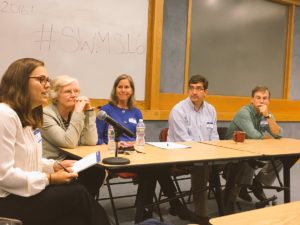By Sarah Cooley

“Do things that terrify you on a regular basis.”
When my mentor gave me this great advice, she wasn’t recommending I take up skydiving — she was encouraging me to push beyond my comfort zone to grow personally and professionally.
Science conferences are great places to terrify yourself a little in the name of professional development. But you’ve got to have a plan to make the most of them. It’s too easy for introverts to tell themselves that browsing posters is the best use of their free time. Extroverts may tell themselves that working the room at happy hour is enough. A better way to make the most of a conference is to set personal challenge goals and develop a plan for before, during and after the conference. Even after almost two decades of science conferences, networking happy hours still terrify me, so I make myself attend at least one every meeting.
What’s your goal?
Before you even submit your abstract, think about how this conference fits in with your career development. Too often, we fall back on the basic, obvious answer: “I’m going to present my new research project.” While that’s a good reason to go, and will certainly justify spending grant money, think about why this conference is the best choice. Whom do you expect to see there? What do you want to learn? Work on some “SMART” goals for the meeting. Honing in on something specific, measurable, achievable, realistic, time-bound will take you from “I’m going to line up a postdoc” to something like, “I’m going to introduce myself to Dr. A and Dr. B and ask if we could write proposals together this fall that would provide me postdoc support in one of their labs by next July.”
Preparing to succeed
Preparing for the conference involves more than putting together (and practicing!) an awesome talk or poster. It’s more than remembering your lucky socks.

Figure out who’s going to be there and make a wish list of presentations you want to see, and people you want to meet. Get in touch with key contacts ahead of the meeting and schedule a time to meet one-on-one. You’ll probably have to chase people down a little, and you might have to settle for a phone call after the meeting. Remember, they’re networking too.
Before you go, work with communications professionals at your institution before and during the conference to identify any press opportunities. Promote your presentation on social media and use the conference’s official hashtag so they can share your posts. This approach is particularly effective for Twitter but could also be effective for other platforms. Plan on attending side events hosted by your institution, professional groups or activities related to your expertise.
Wash your hands a lot in the week before the conference and during the event, too. Travel-wrecking viruses are real and vicious, and they will flatten you.
Putting your best foot forward
Consider yourself on the job the whole time you’re at the conference, even if your presentation is over. If you don’t know many people, find even one person who’s better connected than you and ask them to introduce you to some key people. Participate in, and take full advantage of, mentoring programs. Pass out your business card like confetti. Get others’ cards in return, and jot a note on the back about when/where you met them and what they’re interested in.
Treat every interaction you have as a “job talk”—you could be laying the foundation for future funding, inspiring a recent graduate or making a good impression on your next employer.
On appearances – present yourself in the way that you want to be perceived. First impressions are important so be deliberate in your choice of attire and accessories.

Cultivate your online impression by reminding people to attend your presentation on social media. Be an active participant in the social media conversation during the meeting as best you can. Use pictures and video to increase shares and likes. Ask a colleague or friend to live-tweet your talk. Consider including your social media handle on your materials with your contact information. Participate in the social media conversation around the meeting beyond your own presentation.
Building on success
When you get home, you’re not quite done. Go back to the SMART goals you wrote down before the meeting, and note your progress. Take the next step towards achieving those goals, or set new ones. Think about what was terrifying before the conference that seems easier now, and where you still need to challenge yourself next time. Write it all down – by the next conference, you’ll be able to look back and see how far you’ve come.
Follow up with the people you met, even just by sending a quick one-line “nice to have met you” email or an invitation to connect on social media that reminds them who you are. Pass along contacts you made that could help out other colleagues. Thank the session or conference organizer for having you, and offer to make your materials publicly available.
Put any big lessons learned into a personal blog post or offer it as a guest post for an organization (like SWMS!). Update your peers and colleagues, and spend a little focused time thinking about how you’ll use your new knowledge and ideas. After all that, you can really put your feet up—you will have made the absolute most of this opportunity.
A big thank you is in order to Trishna Gurung, Michelle Frey, and Amanda Creekmore at Ocean Conservancy, who recently compiled many of these ideas for an internal memo. That list, plus some of my own experiences, brought you this blog post today.
Sarah Cooley, Ph.D. is the director of Ocean Conservancy’s Ocean Acidification Program. Before that, she was a research scientist at Woods Hole Oceanographic Institution. She’s attended and hosted countless big and small conferences, learning something new about the process each time.
